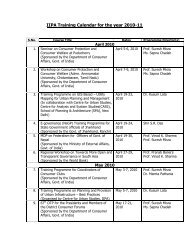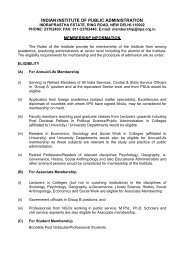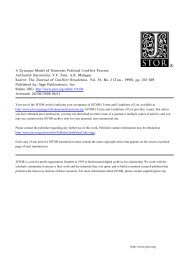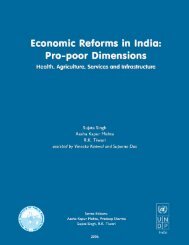Privatisation of Health Care in India - Indian Institute of Public ...
Privatisation of Health Care in India - Indian Institute of Public ...
Privatisation of Health Care in India - Indian Institute of Public ...
- No tags were found...
Create successful ePaper yourself
Turn your PDF publications into a flip-book with our unique Google optimized e-Paper software.
Structure and Characteristics <strong>of</strong> Private <strong>Health</strong> <strong>Care</strong> Providers <strong>in</strong> <strong>India</strong>districts <strong>in</strong> Andhra Pradesh amply demonstrated this. Thebed strength <strong>of</strong> the private sector was much higher <strong>in</strong> thebetter-developed districts than the backward ones (Jesaniand Anantharam, 1993; Baru, 1993). This pattern is seenacross states as well. There is a paucity <strong>of</strong> data on <strong>in</strong>dividualpractitioners s<strong>in</strong>ce the only source <strong>of</strong> <strong>in</strong>formationavailable is the registration data from the various medicalcouncils. This data is limited because not all practitionersare registered with these councils and there is also a greatdeal <strong>of</strong> cross practice across systems <strong>of</strong> medic<strong>in</strong>e (Baru,1993; Duggal, 2001). Duggal estimates that there are approximately12 lakh practitioners <strong>in</strong> the country and theyare concentrated <strong>in</strong> states like Maharashtra, Gujarat andthe southern states. The allopathic doctors constitute about45 percent <strong>of</strong> the total registered practitioners and are locatedmostly <strong>in</strong> urban areas, whereas non-allopathic practitionersare mostly located <strong>in</strong> the smaller towns and ruralareas (Duggal, 2001).At the secondary level <strong>of</strong> care, which consists <strong>of</strong> nurs<strong>in</strong>ghomes, the economically developed states like Maharashtra,Punjab, Tamil Nadu and Gujarat have a higher proportion<strong>of</strong> beds <strong>in</strong> the private sector compared to the public sector(Table 4). Relatively poorer states such as Orissa, MadhyaPradesh, Uttar Pradesh and Rajasthan have low privatesector growth. The growth <strong>of</strong> corporate hospitals is largelya phenomenon <strong>in</strong> those states, which have agrarian prosperityand also have strong NRI l<strong>in</strong>ks. For the three statesunder study the trends are clear: Maharashtra is the highprivate sector growth state, Karnataka falls <strong>in</strong> the middlerange and Orissa is a poor state with very little privatesector growth. The trend <strong>in</strong> the growth <strong>of</strong> private bedsrelative to public beds, from the seventies to the n<strong>in</strong>eties,<strong>in</strong>dicates that the number <strong>of</strong> private beds has doubled overthe twenty-year period <strong>in</strong> Karnataka. In Maharashtra, privatebeds have <strong>in</strong>creased four and a half times dur<strong>in</strong>g thesame period, while for Orissa there has been no growth–<strong>in</strong> fact there has been a decrease <strong>in</strong> the number <strong>of</strong> privatebeds dur<strong>in</strong>g this period (Table 4).A survey done by the Karnataka government <strong>in</strong> 1996 onnon- government facilities shows that there are a large number<strong>of</strong> <strong>in</strong>stitutions <strong>in</strong> this sector at the secondary and tertiarylevels <strong>of</strong> care. 89 percent <strong>of</strong> these <strong>in</strong>stitutions weregeneral hospitals with total a bed strength <strong>of</strong> 36,042, followedby those that provided only maternal and child healthservices (10.04 %) and the rema<strong>in</strong><strong>in</strong>g provided specialistservices like ophthalmology and oncology (Government<strong>of</strong> Karnataka, 2001, pp.29-30). In terms <strong>of</strong> ownership83.38 percent <strong>of</strong> these <strong>in</strong>stitutions were promoted by <strong>in</strong>dividuals,7.49 percent were partnerships, 3.98 percent werecharitable trusts 2.46 percent were registered societies, 1.58percent were religious missions and 1.11 percent were limitedcompanies. Nearly 52 percent <strong>of</strong> the total beds were<strong>in</strong> the category <strong>of</strong> <strong>in</strong>stitutions promoted by <strong>in</strong>dividuals.This data does not provide <strong>in</strong>formation on the distribution<strong>of</strong> these <strong>in</strong>stitutions with<strong>in</strong> Karnataka, but the general patternis that they are mostly located <strong>in</strong> urban and its peripheries..Karnataka does have a sizeable private sector, but thereis no system for registration. Hence, there is an <strong>in</strong>completepicture <strong>of</strong> the private sector. In recent years there has beenan <strong>in</strong>crease <strong>in</strong> the number <strong>of</strong> nurs<strong>in</strong>g homes and corporatehospitals especially <strong>in</strong> urban areas (Government <strong>of</strong> Karnataka,2001). In terms <strong>of</strong> accessibility <strong>of</strong> services there are considerableregional variations <strong>in</strong> both the private and public sectors.North Karnataka has poor <strong>in</strong>frastructure <strong>in</strong> terms <strong>of</strong>roads, communications and transport facilities, while southernKarnataka has better <strong>in</strong>frastructure facilities, which hasan impact on accessibility and utilisation.In Maharashtra, a few studies have focussed on the publicsector and the regional variations <strong>in</strong> terms <strong>of</strong> its distribution.The more developed regions <strong>of</strong> Marathwada andKonkan have better facilities and access as compared tothe poorer region <strong>of</strong> Vidarbha (Budhkar, 1996). Budhkarobserves that there has been a strong tradition <strong>of</strong> localbodies <strong>in</strong> the provision<strong>in</strong>g <strong>of</strong> health services <strong>in</strong> Maharashtra.Dur<strong>in</strong>g the late seventies those regions that experiencedagrarian prosperity viz. Marathwada and parts <strong>of</strong> Konkan,also witnessed a spurt <strong>in</strong> the growth <strong>of</strong> the private sectorat the secondary level <strong>of</strong> care. She also shows that dispensariesand small nurs<strong>in</strong>g homes, which are skewed <strong>in</strong> favour<strong>of</strong> urban areas, dom<strong>in</strong>ate the private sector. This trendwas observed <strong>in</strong> a study <strong>of</strong> the distribution <strong>of</strong> NGOs <strong>in</strong>Maharashtra, where there was a greater concentration <strong>in</strong>13

















